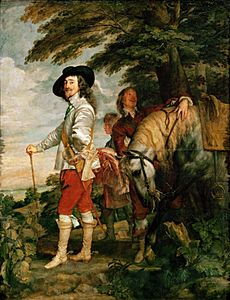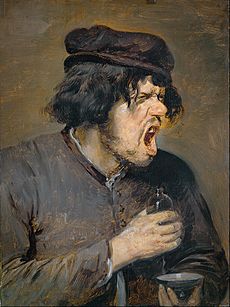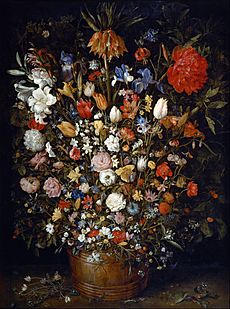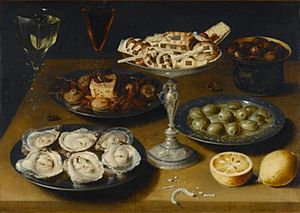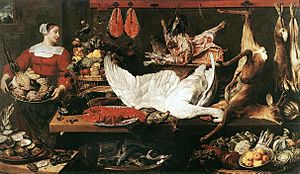Flemish Baroque painting facts for kids
Flemish Baroque painting was a special art style. It was popular in the Southern Netherlands (modern-day Belgium) when Spain ruled the area. This period started around 1585. That's when the Spanish took back the city of Antwerp from the Dutch Republic. The style lasted until about 1700, when Spanish rule ended.
Antwerp was the most important art city. Famous painters like Peter Paul Rubens, Anthony van Dyck, and Jacob Jordaens lived there. Other important cities were Brussels and Ghent. Rubens had a huge impact on art during this time. His new ideas made Antwerp a top art city in Europe. This was especially true for art linked to the Counter Reformation. His student, Van Dyck, also changed how portraits were painted in England. Flemish Baroque painting also had many types, like history painting, portraits, everyday scenes, landscapes, and still life.
Contents
What is Flemish Baroque Painting?
The word "Flemish" in art often means areas beyond modern Flanders. This includes places like the Duchy of Brabant. By the 1600s, Antwerp was the main city for new art. This was mostly because Rubens worked there. Brussels was also important because the royal court was there.
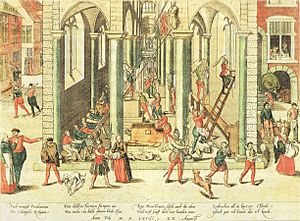
Art Before Rubens: Late Mannerism
Art from the late 1500s was part of a style called Northern Mannerist. Artists like Otto van Veen and Marten de Vos were important. They helped set the stage for the Baroque style. After 1585, many new altarpieces were made. These replaced the ones destroyed during the Iconoclastic riots of 1566. During this time, Frans Francken the Younger and Jan Brueghel the Elder became known. They painted small cabinet paintings. These often showed stories from myths or history.
Rubens's Big Influence
Peter Paul Rubens (1577–1640) was a student of Otto van Veen. He spent eight years in Italy (1600–1608). There, he studied old Roman art and Italian Renaissance art. He also learned from artists like Caravaggio. When he returned to Antwerp, he opened a big studio. He taught many students, including Anthony van Dyck. Rubens greatly shaped Flemish art. Most artists in Antwerp in the early 1600s were influenced by him.
Working Together: Special Artists
Flemish art is famous for artists working together. This happened because many artists specialized in one area. For example, Frans Snyders painted animals. Jan Brueghel the Elder was known for landscapes and plants. Both artists worked with Rubens. Rubens often painted the people in their joint artworks.
New Ideas in Art
Flower still life paintings started around 1600. Artists like Jan Brueghel the Elder helped create this new style. It was also popular in the Dutch Republic. In Antwerp, this new type of painting became a Catholic art form. It was called the flower garland. Other unique Flemish Baroque paintings include large hunting scenes by Rubens and Snyders. Also, gallery paintings by artists like Willem van Haecht were popular.
History Paintings
History painting was seen as the most important type of art in the 1600s. It included stories from the Bible, myths, and history. Abraham Janssens was a key history painter in Antwerp. But after 1609, Rubens became the main artist. Both Van Dyck and Jacob Jordaens painted large history scenes. After Rubens died, Jordaens became the most important Flemish painter.
Other artists influenced by Rubens include Gaspar de Crayer and Cornelis de Vos. Later in the century, history painters mixed Rubens's style with classicism and Italian Baroque ideas. Artists like Erasmus Quellinus the Younger did this. Some painters, like Pieter Thijs, were also inspired by Anthony van Dyck.
Religious Paintings
Rubens is well known for his Baroque altarpieces. One famous example is the Descent from the Cross (1611–14). This large painting was made for a church in Antwerp. It shows ideas from the Counter-Reformation. It also has Baroque features like realism and strong movement. People said this painting could deeply move anyone who saw it.
Portraits
Rubens painted many portraits, though it wasn't his main focus. He painted his wives and many friends. He also greatly influenced portrait art through his student, Anthony van Dyck. Van Dyck became the official painter for Charles I of England. He had a big impact on English portrait painting. Other good portrait artists were Cornelis de Vos and Jacob Jordaens. Some artists, like Gonzales Coques, specialized in small group portraits.
Everyday Life Scenes (Genre Painting)
Genre paintings show scenes from everyday life. They were very common in the 1600s. Many artists followed Pieter Bruegel the Elder's style. They painted "low-life" scenes of peasants. But "high-life" scenes were also popular. These showed stylish couples at parties or in gardens.
Bruegel's Style Lives On
Flemish genre painting was strongly linked to Pieter Bruegel the Elder. His sons, Pieter Brueghel the Younger and Jan Brueghel the Elder, continued his style. They made copies and new paintings. Many showed village festivals (kermis) or peasants enjoying outdoor activities. These scenes were often viewed from above.
Adriaen Brouwer and His Followers
Adriaen Brouwer (1605 or 1606–1638) usually painted small scenes. They showed rough peasants fighting or playing games. Brouwer spent time in Amsterdam and Haarlem. He learned a loose, painterly style there. When he returned to Antwerp, he started painting these scenes indoors. He also painted expressive faces, called tronies. Brouwer's art was very popular and influenced many artists. Rubens owned more of Brouwer's paintings than any other artist's. Artists like David Teniers the Younger continued his style.
Elegant Company Scenes
Paintings of elegant couples were common. They often showed themes of love or the five senses. Artists like Hieronymus Francken the Younger and David Teniers the Younger painted these. Rubens's Garden of Love is an example of this style.
Large Everyday Scenes
Some artists were inspired by Caravaggio. They painted large, dramatic scenes. These showed musicians, card players, or fortune tellers. The figures were often pushed to the front of the painting. These paintings used strong lighting effects. Adam de Coster and Theodoor Rombouts were key artists in this style.
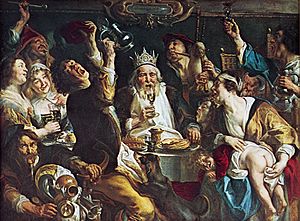
Jacob Jordaens's Big Scenes
Jacob Jordaens became Antwerp's most important artist after Rubens died in 1640. He is famous for his large genre paintings. Examples include The King Drinks. Many of his paintings used lighting ideas from Caravaggio. His subjects also inspired Dutch artists like Jan Steen.
Battle Scenes
Another popular type of painting was landscapes with battles. These included historical fights and robberies. Sebastiaen Vrancx and his student Peter Snayers specialized in this. Snayer's student, Adam-Frans van der Meulen, continued painting them until the end of the century.
Artists in Rome: Bamboccianti
Many northern artists traveled to Italy in the 1600s. Flemish artists like Jan Miel went to Rome. There, they were influenced by genre painters called the Bamboccianti. These were mostly Dutch and Flemish artists. They brought their peasant painting traditions to Italy. They made small paintings or etchings of everyday life for common people in Rome. The Dutch painter Pieter van Laer started this style. He was nicknamed "Il Bamboccio."
Landscapes and Seascapes
Early Landscape Painting
Gillis van Coninxloo was an important landscape painter in Antwerp in the late 1500s. He started painting more natural views. Before him, artists often painted "world landscapes." He influenced northern landscape painting. Forest and mountain landscapes were painted by Abraham Govaerts and Joos de Momper. Paul Bril lived in Rome. He specialized in landscapes for Roman villas.
Rubens and Later Landscape Artists
Jan Wildens and Lucas van Uden painted natural landscapes. They were inspired by Rubens. They often worked with other artists. They would paint the backgrounds, while others added people or animals. Rubens started painting landscapes in the 1630s. He focused on the area around his own castle, Het Steen. A famous example is the Landscape with a view of 'Het Steen'.
Marine Painting (Seascapes)
Small seascapes were also popular. Artists like Bonaventura Peeters painted shipwrecks. They also painted ships at sea or imaginary views of faraway ports. Hendrik van Minderhout continued this theme.
Architectural Painting
Interior views of buildings, especially churches, became popular. This style grew from the works of Hans Vredeman de Vries in the late 1500s. Many paintings showed real places. Pieter Neeffs I, for example, painted many interiors of the Cathedral of Our Lady, Antwerp. Hendrik van Steenwijk II painted imaginary interiors. This type of painting continued later in the 1600s.
Gallery and Art Collection Paintings
Gallery paintings appeared in Antwerp around 1610. They showed collections of art. One early artist in this style was Frans Francken the Younger. He created "walls of treasures." These paintings showed prints, sculptures, and natural objects. They were arranged like a "cabinet of curiosities."
Jan Brueghel the Elder and Rubens also made paintings showing collections. Later, David Teniers the Younger painted the art collection of Archduke Leopold Wilhelm of Austria. These paintings showed actual artworks in a fantasy gallery. People would be shown admiring the art. Flemish gallery paintings are like a visual way of thinking about art.
Still Life and Animal Painting
Flower Painting
Jan Brueghel the Elder was a key artist in flower still life around 1600. His paintings showed perfect arrangements of flowers. These flowers often bloomed at different times of the year. These paintings were popular with rich buyers. They often had a hidden meaning about life not lasting forever (a Vanitas motif). Brueghel's sons, Jan Brueghel the Younger and Ambrosius Brueghel, also specialized in flowers.
Garland Painting
Flower garland paintings were a special type of still life. Jan Brueghel created them with Cardinal Federico Borromeo. Early versions showed the Virgin Mary and Christ child surrounded by flowers. These paintings were important for the Counter-Reformation. They showed the beauty of Mary and Jesus. Their images had been destroyed during the 1566 riots. Brueghel's student, Daniel Seghers, also painted many of these for people all over Europe.
Breakfast and Banquet Still Life
The ontbijtje, or "little breakfast," was a popular still life type. It showed food and drink like cheese and bread. Artists like Osias Beert and Clara Peeters made these. More detailed were the pronk or "sumptuous" still lifes. These showed expensive items, rare foods, and fruit. They were often large and complex. These paintings also reminded people that life is short.
Animal Still Life
Frans Snyders (1579–1657) painted large still lifes. They focused on dead animals and game. His paintings, and those of his follower Adriaen van Utrecht, were grand and monumental. Later artists like Jan Fyt added living animals to these scenes. These paintings are linked to hunting images, which became popular in the 1600s.
Hunting Scenes
Rubens brought large-scale hunting scenes to Flemish art. He showed fierce battles between hunters and animals. He was inspired by old Roman art and Leonardo da Vinci's Battle of Anghiari. These paintings showed both noble hunts (like wolf hunts) and exotic hunts (like lion hunts). Frans Snyders and Paul de Vos also made big hunting paintings. Their works focused more on the animals themselves.
Cabinet Paintings
Small, detailed paintings were very common in the Southern Netherlands. They usually showed history or Bible stories. Many were made by unknown artists. But artists like Jan Brueghel the Elder and Frans Francken the Younger were successful cabinet painters. These artists were still partly influenced by the Mannerist style. However, Rubens influenced many later artists. They added his Baroque style to these small works. These small paintings were sold all over Europe. They even went to Latin America through Spain.
See also
 In Spanish: Pintura barroca de Flandes para niños
In Spanish: Pintura barroca de Flandes para niños
- Antwerp school
- List of Flemish painters
- Flemish painting




